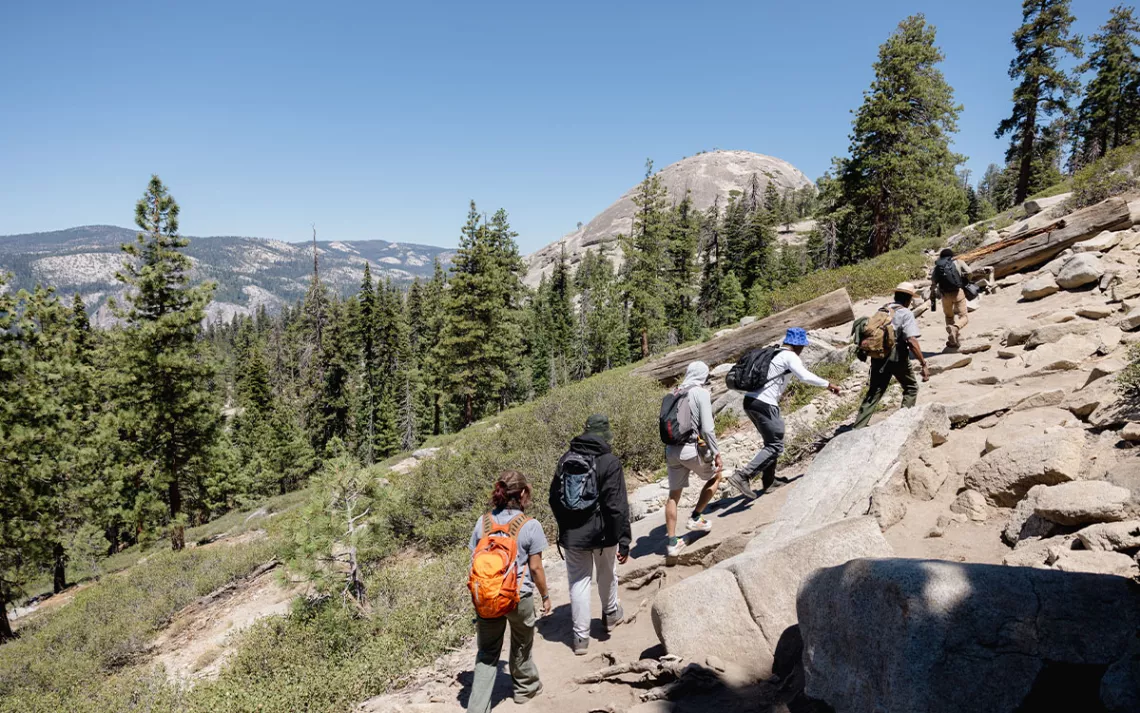Canada's First Nations Do Conservation Their Way
Indigenous Guardians protect lands through litigation, direct action, diplomacy

Illustration by Li Zhang
THE MISIPAWISTIK CREE NATION is located in country so beautiful that the Canadian government considered making it a national park for decades. This boreal-forest region—also home to three other First Nations—is studded with white-sand beaches, limestone cliffs, and a lake that turns brilliant turquoise in warm weather.
A national park could benefit the region: blocking mining claims, freeing up money to restore landscapes damaged by a century of logging and hydropower, and paying for basic services like garbage pickup—cars dump trash by the side of the road, and that turquoise lake doesn't have a single trash can nearby. But in the mid-2000s, when Manitoba Lowlands National Park was close to becoming a reality, the Misipawistik Cree halted negotiations.
Planning for the park had started, says Heidi Cook, an elected councilor of the Cree, with all the groups figuring out what goals they had in common. That was easy enough—everyone wanted to protect the forest. When they began talking about specifics, though, things broke down. "Canada has an interest in representative landscapes and eco-regions and that kind of thing," Cook says. To the Cree, the lands and waters aren't "representative" of anything—they are an extension of themselves and their well-being.
The Misipawistik Cree had a history of Canada looking at their much-beloved lands and waters and making decisions that benefited people far away but devastated the people who lived there. The word Misipawistik means "rushing rapids" in Cree, but no one who lives there has heard the rapids since the 1960s, when the Manitoba provincial government built a hydroelectric dam across the Saskatchewan River.
In an oral history, residents describe the eerie silence after the dam was completed, feeling hunger for the first time as fish and wildlife numbers plummeted, and the horror of eating canned food after a lifetime of walleye (known locally as pickerel), sturgeon, and wild game. "I've never known the rapids," Cook says. "But I still miss them, and I still grieve."
Drawing up boundaries and establishing a new national park—especially one close to Winnipeg—would bring in thousands of visitors who wouldn't have the same understanding of the lands and waters that the Cree do. In 2001, the province of Manitoba designated a network of caves used by little brown bats as a provincial park reserve and named it after Cook's grandfather, a subsistence hunter who had helped government scientists track endangered species.
Seven years later, a student with a group of schoolchildren visiting the park started a fire that burned over 200 square miles. It happened during the height of the dry season, a time when no local would have thought to start a fire. "In the eyes of the Cree Nation, this protected area did not protect the area at all," Cook says. Instead, mapping out a protected area had been the equivalent of drawing a target around it. After the fire, the Cree negotiated to make the caves an ecological reserve—the strictest designation the province had. As part of the agreement, the reserve disappeared from most public maps.
The Misipawistik Cree wanted to protect their lands, but they wanted to do so on their own terms. "We don't really have to manage moose," Cook says. "We have to manage people." So last year, the Cree did something that they'd been talking about for a decade: They started an Indigenous guardian program.
Defining what exactly an Indigenous guardian is can be difficult because programs vary so much, depending on the needs of communities. The Haida established one of the earliest modern guardian programs after using a mixture of litigation, direct action, and diplomacy to block clearcutting on the British Columbian archipelago of Haida Gwaii in the 1970s and '80s. When tourists, lured by tales of the Great Bear Rainforest and totem poles in the mist, began appearing at Haida Gwaii's sacred places, the Haida took shifts patrolling and camping at the sites, both to educate visitors and to make clear that just because a former village was slowly decaying didn't mean it was cool to take souvenirs.
In the 1990s, the Haida joined forces with other First Nations along the coast of British Columbia to collaborate on marine and forest conservation. It did not go smoothly at first. "There wasn't a lot of love in these rooms," said LaaDaa, stewardship director of the Haida Nation, at a National Indigenous Guardians Network Workshop last year. "We had a sordid past. We used to fight each other. We used to kill each other. But now we're all friends. We play basketball together."
The group that emerged from these meetings, the Coastal First Nations Great Bear Initiative, now hires and trains its members to collect data on fish and wildlife. It has an open-source database—based on a system used by Aboriginal groups in Australia—that watchmen along the coast use to track encounters with poachers, illegal fishing operations, and abalone divers. The group collects "atmospheric benefit dollars" from the Canadian government for protecting the Great Bear Rainforest. It has mastered the bureaucratic art of land-use planning.
Ross Wilson, stewardship director for the Metlakatla First Nation, said at the same workshop, "When our province comes and says, 'We are going to put this in this specific area,' we can say, 'No, our land plan doesn't say that. By the way, it's under conservancy. By the way, we have a management plan for that.'"
The work that Indigenous guardians do is in keeping with the UN-backed scientific consensus that Indigenous people are better at protecting biodiversity in their communities than outsiders. In 2002, Canada embarked on a massive data-collection spree after the passage of the Species at Risk Act and found that many at-risk species could be located on Indigenous land, precisely because that was the only habitat that had escaped development.
In 2016, a nonprofit called the Indigenous Leadership Initiative lobbied the Canadian government for $500 million to create a national Indigenous Guardians Pilot Program. It got $25 million. (By comparison, Canada's most recent budget set aside $300 million over the next three years to encourage Canadians to buy zero-emission vehicles.) Even people involved in the pilot hesitate to say what a national version of Indigenous guardians might look like. "We are not trying to tell anyone what guardianship is," says Julie Boucher, who works with the program. "It is Indigenous-led."
The Misipawistik Cree Indigenous guardian program launched in 2018 with a series of meetings in which members discussed their most urgent problems. One of those problems was moose: Their numbers were declining dramatically, and it was hard to tell whether the decline was the result of new parasites and diseases brought on by climate change, hunters killing them out of season, or pregnant moose's notorious habit of getting hit by cars while licking road salt off Provincial Trunk Highway 6.
Another problem was overfishing. Every year, the hydroplant releases hatchery walleye in the remaining two undammed sections of the Saskatchewan River as atonement for destroying the thriving fishing economy that existed along the rapids before the 1960s. Until those walleye get big enough to migrate out to Lake Winnipeg, they are way too easy to catch. "If you drop a line into the river, you don't even have to wait five minutes until you're pulling fish out," Cook says. "A lot of small ones, but a lot of pickerel."
Last winter, just as the Misipawistik Cree were getting ready to launch their guardian program, the river began to freeze. Ice fishermen set up huts, turning the river into a pickerel free-for-all. The guardians closed down the river, saying that since fishing was the lifeblood of their community, everyone was going to have to stop fishing in the nursery.
"What are you going to do about it?" some locals asked the guardians.
Manitoba conservation officers wouldn't block anyone from fishing if they claimed Native ancestry, but if the guardians reported a tribal member to the Misipawistik Cree government, it could deduct fines from any upcoming disbursements. And it could also ticket any nonmembers for trespassing, since the only route to the ice was through the Cree reserve.
"There were some questions like 'Is this a real law?' Yes, this is our law," Cook says.
The Misipawistik Cree barely have enough money to compensate the guardians—though they do provide honorariums and gas money. Other, older guardian programs have managed to build up trust funds from grants and tourism and recreation fees as a way to mitigate the swings of conservation funding. A business plan commissioned by the Coastal Stewardship Network and TNC Canada (now known as Nature United) found that for each dollar invested in a watchmen program annually, the respective First Nation benefits from at least 10 times that amount.
To achieve that, though, a community needs dollars to invest. In the case of the Misipawistik Cree, Manitoba collects all the revenue from fishing and hunting licenses in the province but pays the Cree just $200 a month to share the data that guardians collect on moose numbers and mortality. Cook spends a lot of time writing grant applications. "There's little pots of money. It's a lot of work to piece them all together to create a pot big enough to do the kind of work that we want to do."
The Misipawistik Cree are considering making their territory into an Indigenous Protected Area, like the recently created Edéhzhíe Protected Area in the Northwest Territories. The Cree would maintain diplomatic channels with the provincial and national governments, but this collaboration in the management of lands and waters would be closer to what the Cree thought they were agreeing to when they first signed treaties with the British government in the 1800s. The dam would stay—at least for a while. "We need to get off fossil fuels and transition to better sources of energy before we can realistically take this dam down," Cook says.
Cook recently met with officials from the Department of Sustainable Development in Manitoba. It was a good meeting—the province's conservation unit is understaffed and grateful for the environmental data that the guardians have been collecting. Still, when Cook left, she had some parting words. She invited the staff to come work for the Cree when they take over once and for all.
This article appeared in the September/October 2019 edition with the headline "This Land is Our Land."
 The Magazine of The Sierra Club
The Magazine of The Sierra Club



